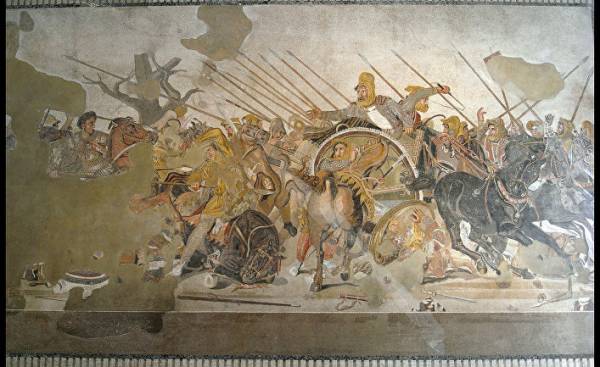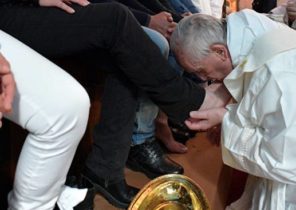
When king Philip V of Macedon entered the war against Rome, he came up with one idea. To raise the morale of his men, he ordered the bodies of the fallen soldiers of the reconnaissance detachment to the camp, to hold them an honorable burial in front of everyone. It is reported by the Roman historian Livy (Titus Livius) in his description of the events of the Second Macedonian war (200-197 years before Christ). But the consequences of good intentions that were quite unexpected.
As the army of the king used to fight only against the Greeks and Balkan tribes, up to this time for them was the usual wounds that leave arrows and spears, but no swords.
But from what they saw this time, they breath: “Now they saw the bodies, mutilated by the Spanish sword (gladius Hispaniensis) — wrote Titus about the new era. — Hands were severed along with the shoulder, head, separated from the body so that the whole head was chopped, dropped out intestine, and other terrible wounds. With comprehensive watched in horror, they, against any people and any weapons they had to fight. Even the king himself was terrified, even before he faced the Romans in this battle.”
150 years earlier, Greek colleague Libya Polybius (Polybios) explained the victory of the legions of inconspicuous weapon with which the Roman generals, apparently, met in the wars against Carthage in the Iberian Peninsula: “the sword men wear on the right side and call it Iberian. Its durable and rigid blade make it not only an excellent weapon, but perfect for powerful strokes from both sides.”
But how exactly could the barbaric weapon to bring the Roman power in the state to win in a few years, the legacy of Alexander the Great. Antigonid Macedonia and the Seleucids of Syria, who reigned in the middle East from Asia Minor to Iran in the East, used the means and tactics, which destroyed the Persian Empire. At their disposal was the armoured horse, elephants, specialists in ranged combat in the Macedonian phalanx, whose lances with a length up to six meters (sarissa) is a formidable weapon.
Technically, the legions have not added to this Arsenal, nothing significant. The absence of military scientific texts of the period, the average of the Republic also indicates that the Roman officers are less engaged in such questions than their colleagues from the Hellenistic Empire where flourished the genre of military literature. Only two authors, Polybius and Livy, was dedicated in his writings passages large organizations of troops that conquered the world in the second and third century before Christ. Both gives the sword the Central value.
Unlike previously adopted, the Iberian sword was not particularly short and, on average, had a total length of 70 centimeters. A shortening of about 20 inches, as is customary in Hollywood films, became a regular only in August, writes in his book “the History of war from the stone age to the late antiquity” a specialist in the history of the ancient world Armin Eich (Armin Eich). “Possibly, Roman generals preferred the Spanish to the sword for so long because about the efficacy of mass production it could relatively easily be made by order of the state by private masters without any cost — it had no decorations and it was aesthetically unpretentious”. Both his blades were almost parallel, extending to the end edge “like a willow leaf.”
The decisive advantage of these weapons was that they could fence. It could be used for both blow and injection. Archaeologist Marcus Junkelmann (Marcus Junkelmann) experienced over many years of ancient weapons in the experiment. His conclusion: “a Shot takes less energy, requires not so much space, is more precise, faster and less predictable. The blow forces the batsman to exhibit is stronger than my body. Kolyat mainly in the face, neck and stomach.”
Even in the IV century BC military theorist Flavius Vegetius Renat (Flavius Vegetius Renatus) pointed out to his readers that an injection depth of two inches can be fatal, punch, in contrast, can easily be given armor or bone. Not in vain the generals urged their people to “aim with the sword in the face.” In addition, the enemy involuntarily sheltering from a stab with a sword, shows weakness, which provokes attack.
Two important subjects of uniforms supported Legionnaire in battle. The first was a lined with metal and wooden shield (Scutum), good protection from the jabs and blows of the enemy, could even be used to block the opponent’s weapon. The second was the spear (the Pilum), prepared so that its edge upon impact bent and complicates the protection of the victim or even destroyed the shield.
Tactics the line of battle was well adapted to battle with swords. Unlike the hoplites of the Greek city-States or pedestiran Macedonia phalanx Legion (five thousand people) was divided into separate units (probe) (about 120 people) and therefore was much more flexible than deeply layered formation of its prototype. In addition, the Legionnaires did not fight side by side, and kept a distance of about one meter from each other (front and side standing). This allowed free fencing with the sword and quick replacement of the rear rows in the case that the warrior is tired, injured or killed. Also a small Roman unit could quickly break away from the enemy and change position.
The Great Hellenistic Empire, which primarily relied on heavy cavalry and deeply echeloned phalanx, armed with carissimi, there is little that could oppose Rome, particularly if the terrain and enemy movement called for a quick regroup. However, the Iberian sword did not give a guarantee for success, as found by Armin Eich: “High energy consumption and the management of multiple simultaneous matches led to the fact that the Roman troops were forced to repeatedly suffer heavy defeat”.
To prevent this, professional army in the later years of the Republic developed new weapons and tactics. The sword of the legionary was shorter, shield — more. There were various types of artillery. But above all, recruited auxiliary troops from Narymsky nationals who brought the Legion has their own ways of battle: cavalry, light infantry, archers, catapultic. They had such a huge impact on the army of the Imperial period that scientists have formulated the thesis that the brunt of the fighting not carrying the Legionnaires and the auxiliary unit. This, at least, the reliefs narrate Tranovo column in Rome, depicting the war against the Dacians in modern day Romania.







